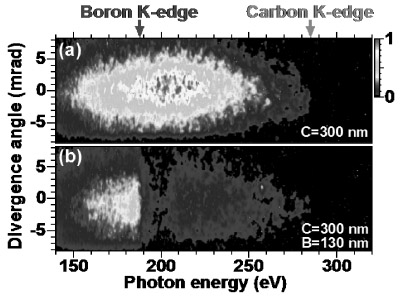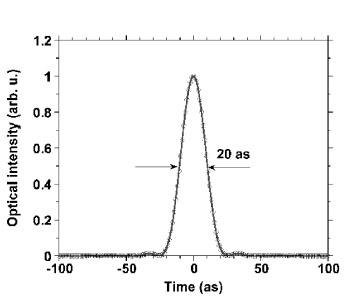Generation of Isolated Attosecond Pulse in Carbon K-Edge (284 eV) Region with Double Optical Gating
Hiroki Mashiko, Tomohiko Yamaguchi, Katsuya Oguri, and Hideki Gotoh
Optical Science Laboratory
As is well known, carbon is important fundamental element of inorganic compounds (graphene, nanotube, etc.) and organic compounds (hydrocarbon, bio cell, etc.). The K-shell absorption edge in carbon [284 eV photon energy (4.4 nm wavelength)] has capability for optical imaging the element. Meanwhile, attosecond (10–18 s: as) pulse is shortest laser pulse in the world. The laser with ultrashort
pulse width would be useful for visualizing of living cell structure. In
order to generate the attosecond pulse with 284 eV photon energy, the peak
intensity of the driving laser should be >1.4×1015 W/cm2 [1]. Here, we report attosecond pulse generation with only 247 µJ pulse energy using a double optical gating (DOG) [2]. The technique is combined with elliptically dependent polarization gating and two-color gating. The temporal gate effect can emphasize the cut-off spectrum component in the pulse.
In this experiment, we used the Ti:Sapphire laser with 247 µJ pulse energy with 7 fs duration. The temporal gate width with DOG was fixed to ~1.3 fs. The driving laser was focused on a cell filled with helium gas (backing pressure: ~1.2 bar, interaction length: 300 µm). The spectrum of generated attosecond pulse was monitored with a soft x-ray spectrometer (resolution: 3.8 eV in the 284 eV region). Figure 1 shows the spectral distribution with (a) the carbon filter and (b) carbon and boron filters. The boron K-edge (188 eV) and carbon K-edge (284 eV) were clearly observed. Consequently, 284 eV pulse were successfully generated from the driving laser with only 247 µJ pulse energy, which pulse energy is lowest value ever reported. In addition, the spectral bandwidth is larger than 140 eV. The Fourier-transform-limited pulse, assuming a flat phase, was 20 as duration as shown in Fig. 2. The value is much shorter than previous reported value of 80 as in the world record [3]. The characteristic time scale for electron motion is atomic unit of time, which is 24 as. The attosecond pulse will have a profound impact on the study of various electron dynamics in the carbon K-edge region.
- [1]
- Z. Chang et al., Phys. Rev. Lett. 79 (1997) 2967.
- [2]
- H. Mashiko et al., Appl. Phys. Lett. 102 (2013) 171111.
- [3]
- E. Goulielmakis et al., Science 320 (2008) 1614.
 |
 |
- Fig. 1.
- Spectral distribution of attosecond pulse with
(a) carbon filter and (b) carbon and boron filters.
|
- Fig. 2.
- Fourier-transform-limited pulse.
|
|
<< Prev | Contents | Next >>

